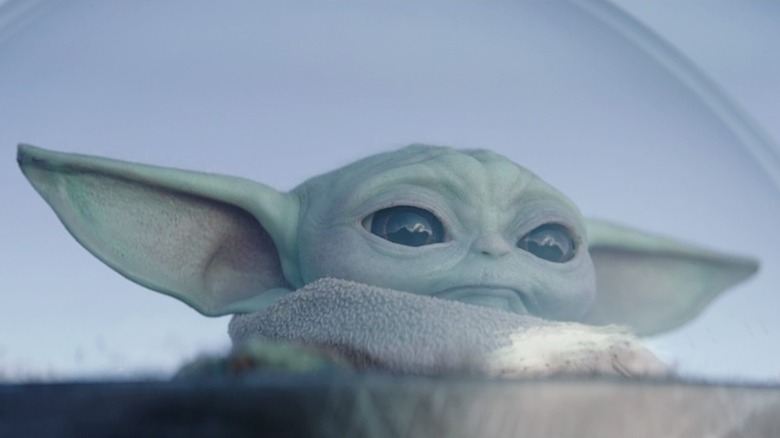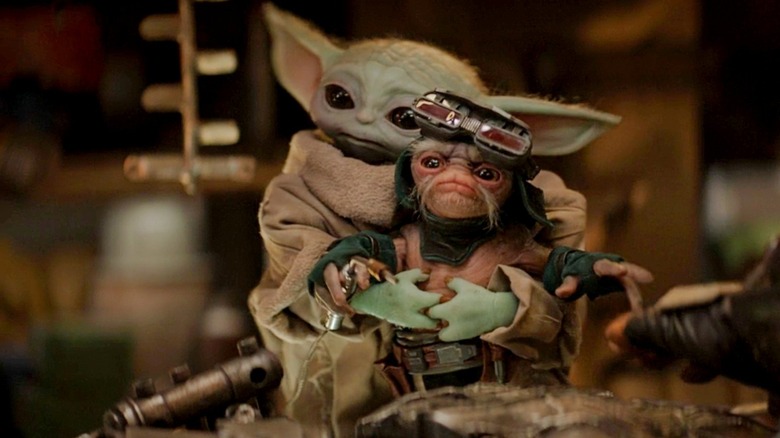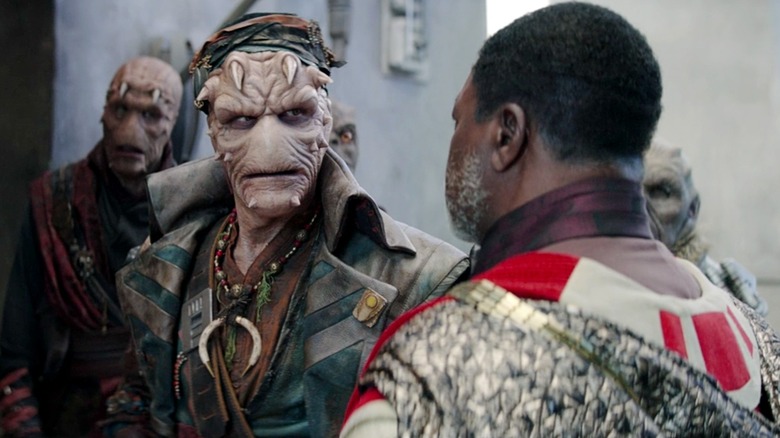The Mandalorian Season 3 Premiere Tries To Be Like Star Wars Animation - Does It Work?
This post contains spoilers for "The Mandalorian" season 3.
It was always going to take some adjusting, returning to "The Mandalorian" after "Andor." Whereas Tony Gilroy's "Rogue One" prequel is a visually muddy, tonally adult war drama that wears its anti-fascism message proudly on its sleeve, Jon Favreau's "Lone Wolf and Cub"-inspired live-action series is an overall lighter mix of samurai adventure and Spaghetti Western homages that unfolds during an era of relative peace in a galaxy far, far away. There's nothing inherently wrong with that, either. I've said it before and I'll say it again: "Star Wars" can be (and should be allowed to be) many things.
In terms of its world-building and style, "The Mandalorian" has always existed somewhere near the nexus between the live-action and animated sides of the "Star Wars" universe, not least of all compared to "Andor." Perhaps it's just the juxtaposition of Gilroy's corner of the franchise to Favreau's, but it seems as though "The Mandalorian" is trying even harder to be like "Star Wars" animation with its season 3 premiere, "Chapter 17: The Apostate." Certainly, the appearance of purrgils from "Star Wars Rebels" contributes to that feeling, yet it's more than that. The episode is full of gargantuan creatures, tiny critters, and non-human space pirates, the likes of which are commonplace to animated shows like "Rebels" and "The Clone Wars."
Granted, many of the creatures, or similar ones, have not only shown up in live-action before, they actually originated there (Example: the Anzellan droid smiths on Nevarro). It also makes sense for "The Mandalorian" to shuffle ever closer to the vibe of "Star Wars" animation during season 3, as it continues to lay the groundwork for "Ahsoka" — a spinoff that will essentially act as a sequel series to "Rebels". Whether this approach is working, however, is another matter.
Family-friendly or comfort food?
There's a widely-circulated joke on social media that "The Mandalorian," for all its merits, feels more like a TV series the characters on "Andor" would watch, as opposed to a show that exists in the same sci-fi reality. (That goes double for its spinoff series, "The Book of Boba Fett," with its zany cyborg biker gang hijinks.) The season 3 premiere doesn't exactly refute that sentiment, either. Between Kowakian monkey-lizards chilling in trees, the Swamp Thing-like pirate captain Gorian Shard, and the fundamentally hilarious image of Din Djarin sitting hunched over in the Anzellan droid smiths' workshop (all on top of Grogu's constant presence, love him or hate him), "The Apostate" happily indulges in the sillier, pulpier aspects of "Star Wars."
So why doesn't it really work for me?
Now, before y'all accuse me of hating fun or insisting "Star Wars" be Very Serious™ all the time post-"Andor," I think part of the issue is the approach. "Rebels" and "Clone Wars" got darker and more mature as they went along, yet there was always a place for silliness. Heck, the "Rebels" episode "The Future of the Force" even found room for cutesy baby-related shenanigans in an otherwise deadly-serious plotline about child abduction. Season 2 of the "Clone Wars" spinoff "The Bad Batch" has similarly made space for lighter episodes about racing or "Indiana Jones"-styled expeditions while exploring a larger story about fascism, the exploitation of labor, and the disintegration of individual rights.
General opinions undoubtedly vary, but most of the time I feel these lighter elements work to keep these shows family-friendly without distracting too much from the heavier topics being raised. By comparison, the sillier moments in "The Apostate" too often come across as comfort food that winds up downplaying the drama starting to unfold.
This still might be the way
The tone is also part of the issue here. In a live-action "Star Wars" movie like "Return of the Jedi," the members of Jabba the Hutt's criminal entourage (including everyone's favorite Kowakian monkey-lizard, Salacious B. Crumb) are afforded a threatening quality that's missing from the similar baddies in "The Apostate." It's a recurring problem in Disney-era live-action "Star Wars"; the sharper edges of the franchise are often sanded down, resulting in villains who are as pulpy as the ones in George Lucas' original trilogy yet lack the air of genuine menace (or, in some cases, the grosser qualities) that made them work. "Star Wars" animation usually manages to offset this by embracing a darker color palette and unsettling character designs. But in the brighter, digitally-polished world of "The Mandalorian," a group of space pirates grumbling about their favorite bar being turned into a school simply doesn't stick the landing as well.
Obviously, this is in no way meant to write off "The Mandalorian" season 3 right away, and after an episode mostly focused on table-setting anyway. The show has always been more of a cozy blanket compared to the spiritual darkness of "Andor" and the wartime drama of the various "Star Wars" animated series, and maybe it should stay that way. (Once more, with feeling: "Star Wars" need not be just one thing.) Still, as both this season and future spinoffs continue to bridge the gap between the live-action and animated sides of a galaxy far, far away, my hope is "The Mandalorian" will learn the lesson "Star Wars" animation did many years ago where it concerns how to balance seriousness with silliness. There's no dark side with the light, after all.
New episodes of "The Mandalorian" season 3 premiere Wednesdays on Disney+.


